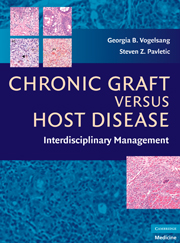Book contents
- Frontmatter
- Contents
- List of Contributors
- Preface
- PART I GENERAL PRINCIPLES
- 1 Historical Aspects of Chronic Graft versus Host Disease
- 2 The Pathophysiology of Acute Graft versus Host Disease
- 3 Pathophysiology of Chronic Graft versus Host Disease
- 4 Animal Models of Chronic Graft versus Host Disease
- 5 Incidence and Trends
- 6 Clinical Manifestations and Natural History
- 7 Risk Factors and Predictive Models for Chronic Graft versus Host Disease
- 8 Biomarkers in Chronic Graft versus Host Disease
- PART II CLINICAL MANAGEMENT
- PART III ORGAN SITE OR SYSTEM-SPECIFIC MANIFESTATIONS
- PART IV SPECIAL CONSIDERATIONS IN CHRONIC GVHD
- Index
- Plate section
4 - Animal Models of Chronic Graft versus Host Disease
from PART I - GENERAL PRINCIPLES
Published online by Cambridge University Press: 26 August 2009
- Frontmatter
- Contents
- List of Contributors
- Preface
- PART I GENERAL PRINCIPLES
- 1 Historical Aspects of Chronic Graft versus Host Disease
- 2 The Pathophysiology of Acute Graft versus Host Disease
- 3 Pathophysiology of Chronic Graft versus Host Disease
- 4 Animal Models of Chronic Graft versus Host Disease
- 5 Incidence and Trends
- 6 Clinical Manifestations and Natural History
- 7 Risk Factors and Predictive Models for Chronic Graft versus Host Disease
- 8 Biomarkers in Chronic Graft versus Host Disease
- PART II CLINICAL MANAGEMENT
- PART III ORGAN SITE OR SYSTEM-SPECIFIC MANIFESTATIONS
- PART IV SPECIAL CONSIDERATIONS IN CHRONIC GVHD
- Index
- Plate section
Summary
INTRODUCTION
Chronic graft versus host disease (cGVHD) remains a significant barrier to successful allogeneic hematopoietic stem cell transplantation (allo-HSCT). The incidence of cGVHD following allo-HSCT ranges from 25% to 80% and is associated with significant morbidity and mortality. Nonetheless, its association with a lower risk of leukemic relapse suggests an immunologically based antitumor effect. Clinical manifestations of cGVHD are highly variable with respect to organ involvement and extent, and its clinical description is further complicated by different methodologies of clinical scoring to quantitate disease severity. These methodologies have been addressed in a series of efforts in the clinical community through the establishment of the National Institutes of Health Consensus Project on cGVHD.
Chronic GVHD appears to be a distinct clinical and pathologic entity from acute GVHD (aGVHD) and not merely a temporal extension of the latter. In aGVHD, apoptosis in target organs (skin, liver, and gastrointestinal tract) is a characteristic diagnostic hallmark. In contrast, the clinical and pathologic manifestation of cGVHD are protean, with a wide spectrum of disease including skin fibrosis (akin to scleroderma), lacrimal and salivary gland involvement (as observed in Sjörgen's syndrome), fascitis, eosinophilia, bronchiolitis with or without organizing pneumonia and perhaps a distinct form of hepatic GVHD. These features, which are at least in part specific for cGVHD versus aGVHD, have been used to judge whether a mouse model has relevance to cGVHD.
- Type
- Chapter
- Information
- Chronic Graft Versus Host DiseaseInterdisciplinary Management, pp. 31 - 45Publisher: Cambridge University PressPrint publication year: 2009
- 1
- Cited by



